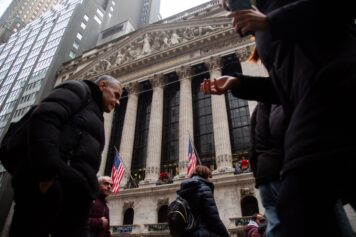By Charlie Wells and Claire Ballentine
America’s central bank increased its benchmark interest rate on Wednesday, pushing it up by a quarter percentage point. The hike — the first since 2018 — was widely expected. But at a time when Russia’s war in Ukraine has roiled global markets, U.S. inflation is at its highest level since the 1980s and COVID-19 cases are increasing in some parts of the world, consumers and investors are contending with the prospect of rates going even higher.

At stake: Will stocks tank or soar? Will the pandemic-induced demand for housing continue even though borrowing costs are going up? And will rate hikes be enough to tame inflation?
“The Fed is faced with a real predicament,” said Lauren Goodwin, economist and portfolio strategist at New York Life Investments. “Even before the Russia-Ukraine crisis, the Fed was facing an inflation problem and also an expectation that economic growth would slow. The overall economic growth impact is less pronounced in the short term, but the longer the conflict drags on, the more risk we will see.”
What the Fed does to interest rates affects nearly every aspect of Americans’ financial lives, from the interest rates on credit cards and auto loans to the returns on their retirement savings.
And this increase is expected to be the first of many. Before the meeting, traders were pricing in a total of seven rate hikes this year and the Fed itself signaled six more hikes after this one.
Here’s what experts say consumers should be mindful of as interest rates rise:
Stocks and Retirement Accounts
An oft-cited theory is that interest rates and stock prices move in opposite directions. The idea is that equity valuations reflect the present value of a company’s future earnings, dividends or cash flows. Higher interest rates make that future money worth less today, which in turn drags down stock prices.
But history tells a different story. During the previous eight hiking cycles, the S&P 500 Index was higher one year after the first increase every single time, according to LPL Financial.
“The intuition is that higher rates are bad for stocks, particularly growth stocks,” said Katie Nixon, chief investment officer of wealth management at Northern Trust. “But if you look back to the post-global financial crisis period, stocks did well. The Fed did increase rates several times over that period, stocks rose and growth stocks outperformed value stocks.”
That’s not carte blanche to go all in on stocks, Nixon said. She worries that some investors, concerned about rising rates, may be overexposing themselves to equities and shunning bonds, bringing too much risk into their portfolios. Bond prices typically fall when interest rates rise.
“Even in a rising-rate environment, fixed income does give you diversification against risk-asset volatility,” she said, noting that a rate hike is a good time for investors to reexamine their asset allocation.
Savings Accounts
The Fed’s hike also means that the rates on so-called high-yield savings accounts will probably increase as well.
These online accounts — like the Marcus product from Goldman Sachs Inc. — became popular in the past decade as an easy way for everyday investors to keep their cash savings fairly liquid yet still earn higher returns than those offered by most regular retail banks.
When the Fed cut interest rates at the onset of the pandemic, the companies behind these accounts lowered their rates as well to maintain profits. In mid-2019, Marcus offered a 2% rate, but it’s now only 0.5%.
Although there will almost certainly be a lag, the rates on high-yield savings accounts will likely move higher as the Fed tightens policy.
“It’s this timing game that everybody is trying to play,” said Matt Miskin, co-chief investment strategist at John Hancock Investment Management. “Do you put something in now? Do you wait until it goes a bit higher?”
Still, it’s going to be a tough environment for savers, with inflation at almost 8%. That underscores the importance of having a balanced portfolio that includes both high-risk, high-return plays as well as safer bets like bonds, Miskin said.
Real Estate
Raging housing prices have everyone asking the same question — when will the market cool down?
The answer is impossible to predict, but some are hoping the Fed’s rate hikes will help temper demand and lower prices. That’s because mortgage rates will likely move higher as well, lessening the appeal of buying a home. Mortgages track the 10-year Treasury yield, which tends to move in the same direction as the Fed’s benchmark rate.
The mortgage market has already priced in some of the impact of higher rates, with the average for a 30-year loan hitting 3.85% last week, up from 3.05% at the same time last year.
“The short-term rate hikes that the Fed will embark on to try to tame inflation will certainly put upward pressure on auto loans and mortgage rates,” said Taylor Marr, deputy chief economist at real estate brokerage Redfin.
Another big factor is the end of the Fed’s bond-buying program, which helped support fixed-income markets during the pandemic. A large portion of the purchases were mortgage-backed securities, contributing to lower mortgage rates. Marr expects program’s end, alongside higher rates, to decrease demand for homes and slow price growth.
In the short term, though, increases in borrowing costs could further pinch homebuyers already struggling with the effects of inflation.
“You’ve got a higher mortgage rate and high costs for food and other things — that’s not going to be easy to manage for everyday people,” Miskin said.
Cryptocurrencies
Bitcoin, Ether and many other tokens have become popular with investors looking for potentially high returns, even if that means more risk compared to traditional assets, like stocks or bonds. Government stimulus checks also prompted new investors to begin trading during the pandemic, and a fair amount of that money ended up in crypto markets.
“Rising rates are like a wet blanket on crypto,” said Matt Hougan, chief investment officer at Bitwise Asset Management. If investors can find yield in lower-risk corners of the market, that suddenly makes crypto less attractive. Bitcoin prices have slumped around 40% from their high in November, and Ether has lost nearly 45%.
However, some recent developments in the crypto space may help reduce its risk. Greater regulatory clarity is taking shape, particularly after President Joe Biden signed an executive order earlier this month that industry participants viewed as “benign.” Institutional investors and venture capitalists have also flocked to the space, giving it more liquidity.
The Future
The number of rate hikes this year will depend on factors like inflation, economic growth and geopolitical risks. Estimates from Wall Street economists vary widely, with some predicting as many as seven total in 2022.
Others believe that estimate is overblown. Miskin at John Hancock expects the Fed to “start like a hawk and end like a dove” this year — essentially, the central bank will raise rates in the first half to combat inflation, but not as aggressively as some are predicting.
“We do believe there is downside risk to the global economy given the Russian war and the spike in commodity prices,” he said. “That’s going to potentially dent global growth.”
For consumers, the biggest focus is likely on inflation, which they can feel in everyday purchases. The Fed hikes will help lower prices, but not immediately, according to Goodwin at New York Life Investments.
“What they are hoping to achieve by raising interest rates is that by increasing the cost of financing they can slow demand on the margin for some of the goods and services that have seen such large increases in prices,” she said. “That process takes time.”
More stories like this are available on bloomberg.com.




